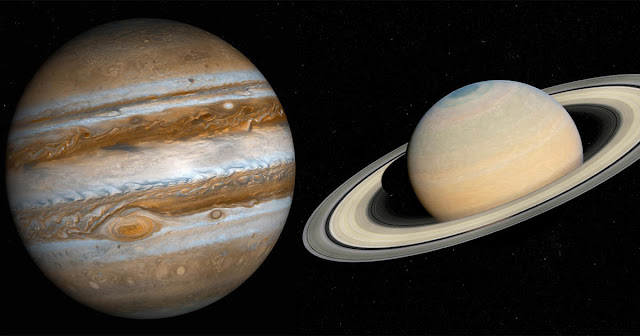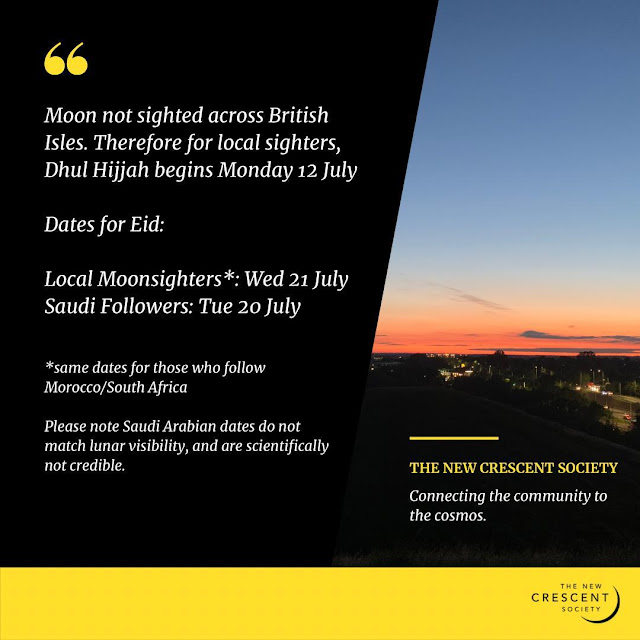When is Ramadan 2022 (1443AH) in the UK?
Imad Ahmed
25 March 2022 / 21 Shaban 1443
Q: When is Ramadan 2022 in the UK? Some people say Saudi always claim to 'see' the moon too early, and will begin Ramadan a day too early. Is that true?
A: The Ramadan dates are given below, together with a full explanation. Yes, Saudi might claim to 'see' the moon on Friday 1 April - a day earlier than it is scientifically possible to see - as they have a history of scientifically impossible sightings.
Please be warned, any claim that the crescent has been seen on Friday 1 April from the UK, Europe, Africa, the Middle East, Asia, and Australia etc is scientifically impossible.
Our predicted dates for Ramadan
 |
| The Ramadan Moon, Royal Observatory Greenwich Livestream with New Crescent Society, 2018 |
Background
How do different mosques/groups in the UK determine their Islamic Calendar date?
There are many different Islamic positions in the UK about how to determine the Islamic Calendar, which naturally leads to differing dates.
There are many ways of framing this debate. For the sake of simplicity in this article, we could divide them into the following camps:
· LOCAL MOONSIGHTERS: this group sights the moon every month in the UK. They determine the Islamic calendar date according to local moonsighting. This was the practice of the Prophet Muhammad (s)
· FOREIGN NEWS-REPORT FOLLOWERS: these groups follow the Islamic calendar of other countries. Some follow Saudi, others follow South Africa, or Morocco, and so on…
This is of course a simplification, but it will help us for the sake of this explanation. Again, more detailed explanations can be found in our blog, our video linked above, and our social media output.
Why do mosques in the UK follow the Islamic Calendar of other countries? That doesn’t make sense!
Although LOCAL sighting is the tradition of the Prophet Muhammad (s), and of Muslims throughout history until today, it has only recently been carried out seriously in the UK.
In the past, mosques who followed other countries did so on the MISTAKEN notion that the moon was not visible in the UK, and thus they falsely believed that we had no choice but to follow other countries.
And this is the root of the problem, because:
- Different countries see the moon on different dates. This is perfectly scientific and natural.
- Different countries begin their Ramadan and Eid on different dates.
- If we, in the UK, have various mosques following various different countries, it is inevitable that we will have different start dates for Ramadan and Eid within the UK.
 |
| Great shot of the hilal by Musa, from Hackney, for the month of Rajab |
 |
| Incredible capture of the crescent, Shaban, from Samira Mian |
Interestingly, the three countries we have mentioned in this article (Saudi Arabia, Morocco, South Africa) all insist that local sighting is the sunnah position, and have advised us in the UK to follow our local moon!
Here is a Saudi scholar advising other countries to follow their own local moon:
Here is an interview that I conducted with the Heads of the Moonsighting Committee of Morocco, where they advise us not to follow Morocco, and to follow our own local UK moon:
What are your predicted Ramadan dates for this year?
This is a predicted lunar visibility map for Saturday 2 April. It demonstrates where the moon is predicted visible on that evening. The data is produced by HM Nautical Almanac Office, which is an historic department of the Royal Observatory Greenwich.
Saturday 2 April is the date that local moonsighters will be looking for the moon in the UK, corresponding to 29 Shaban.
As you can see, the whole of the UK is covered in dark-green, which means the moon should be visible, insha allah, as long as the weather is clear.
In fact, most of the world is covered in dark-green. On this occasion, most (practically all) of the inhabitable world will first see the Ramadan-moon on Saturday 2 April, and thus their first fast will commence on Sunday 3 April.
So for those of us who follow local UK sightings, and indeed those who follow other countries such as Morocco and South Africa, we predict that we will all begin our first fast on Sunday 3 April, insha allah.
Why do you predict Saudi might claim to 'see' a scientifically impossible moon?
Saudi Arabia will be looking for the moon a day earlier than us here in the UK, on Friday 1 April. This is because they started their previous month (Shaban) a day earlier than us, so their 29 of Shaban corresponds to 1 April.
To be clear - this is the correct date for those in Saudi to look for the moon, as it is their 29 Shaban.
This is the predicted visibility map for Friday 1 April.
As you can see Saudi Arabia (as well as the UK, Europe, Africa, Middle East and Asia) is in ‘clear’ zone, which means it is scientifically impossible to sight the moon on Friday 1 April in Saudi Arabia. There is 0% chance of the moon being sighted there.
You can also read this data yourself on the HM Nautical Almanac Office website - here is a screen grab:
Sadly, Saudi Arabia have a strong history of false moonsightings. This means that Saudi Arabia have historically and continuously claimed to have seen the moon when it is too thin, too small for the human eye to perceive, and indeed have claimed to have seen the moon when it is below the horizon.
Here are some press cuttings reporting similar stories over the years:
Of course, all dates I have predicted are subject to moonsighting insha allah. I may be wrong (indeed I do hope I am wrong) and perhaps Saudi Arabia will do the right thing this year: declare they haven’t seen the moon, and fast on April 3rd.
This would give us a chance for a united Ramadan start date.
But I do want to let you know in advance, on Friday 1 April this year, be vigilant. If your friend, your next door neighbour, or anyone tells you that they have seen the moon in the UK; or if you have heard that the moon was seen in the Middle East, Asia, Africa, or Australia - they might be sincerely mistaken, but know that the moon is not visible on Friday 1 April!
 |
| BE VIGILANT ON APRIL FIRST |
HOW TO SIGHT THE RAMADAN MOON YOURSELF!
Whatever your belief about the Islamic Calendar, we urge you ALL to sight the Ramadan moon for yourself. You'll love the experience.
There is a famous saying of the Prophet Muhammad (s) about Ramadan, which is: Fast when you see [the crescent] - you'll have the chance to live these words on Saturday 2 April
Take your children, your family, go to a park on Saturday 2 April, and see if you can see the moon! It's easy, all you need is a clear view of the sunset.
Here is a one minute video showing you how to see the moon on Saturday
And here is a handy guide. Save it on your phone, and remember to look on Saturday 2 April.
If you SEE the moon on Saturday 2 April, make sure to let us know on social media, Facebook and Instagram!
Let your mosque know you support a unified calendar in the UK, based on local sightings
As such, we will continue to work with communities. You can help us by speaking to your mosque and letting them know of our work, that we would love to work with them, and reassure them that they have your support










What is the error margin on these moon visibility charts?
ReplyDeleteAs much as I laud your efforts, I think it is high time we embraced Global Moonsighting powered by visibility charts and supported by the Ahādith recorded by Imām Bukhāri in 1913 in the Chapter "We neither write nor know accounts" and Imām Muslim in 15 in The Book of Fasting. These Ahadith suggest that a time will come when science will prove that the sun and moon move in precisely decreed courses (Surah ar-Rahmān 55:5) and when we see that time, we should follow those calculations. This can only be achieved when we sacrifice ego for brotherhood, appreciating that the disunity and sheer wasting of time is engineered by shaitān towards his declared goal.
ReplyDeleteAnother part of fasting is "when do we begin and end the daily fast". Again, taking lessons from Ahadith, we should realise that Subh as Sādiq is the true dawn is when the light of the sun spreads horizontally across the horizon is when we can eat till. And Maghrib is at sunset when the disc of the sun goes below the horizon is not 3 minutes after is when we hasten to break the fast and hasten to pray Maghrib.